Today, we’re going to look into a post-code Betty Boop with her little pal, Pudgy!
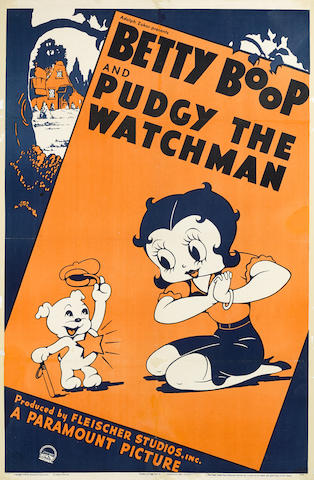 Many of the Fleischer cartoons featuring Betty Boop, including the early Talkartoons before her official series, are among the finest, and zaniest, in early 1930s animation. When the Production Code Administration’s enacted its stranglehold on film censorship, her character changed drastically and the series began to decline.
Many of the Fleischer cartoons featuring Betty Boop, including the early Talkartoons before her official series, are among the finest, and zaniest, in early 1930s animation. When the Production Code Administration’s enacted its stranglehold on film censorship, her character changed drastically and the series began to decline.
While the artists transmitted their stronger capabilities in plotting, timing and staging into their sensational Popeye series, Betty’s character went from lively to modest. Besides the wardrobe change from mini-skirt to knee-length collared dress – that were kept intact in publicity advertisements — Bimbo and Koko the Clown were cast aside in place of different characters – her pet dog Pudgy, her niece Buzzy and a crackpot inventor, Grampy – that often upstaged Betty herself. Pudgy the Watchman is an example of this titular character’s saccharine nature, and it also demonstrates the eccentricities of one-shot try-out characters – in this case, mouse “eradicator” Al E. Katt’s drunken stupor – that often served as the centerpiece.
De-facto director Tom Johnson contributed to the pure comedy sense in his Fleischer cartoons. According to a tintype bio in Fleischer’s Animated News, Johnson displayed an athletic prowess with swimming and relay teams in high school, and even ran a weekly comic strip “Freddie the Freshie” for The Evander News. He attended the State Teacher’s College to become a teacher but received a side job as a sign painter. Johnson arrived at the studio in 1930 starting in the story department, then switched to the animation department. He married his wife – whom he coincidentally went to the same high school with – in November 1934 and spent the remainder of his career at Famous Studios. Johnson’s last work was on the Joe Oriolo Felix The Cat TV series.
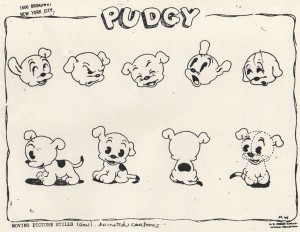 The second animator credited in Watchman, Harold Walker, handled the highest amount of footage in this cartoon. Walker started his career as Otto Messmer’s assistant on the Felix the Cat cartoons in 1920, after Sullivan signed a two-year contract to make cartoons for Paramount Magazine and kept that position for about a decade. He started at Fleischer’s animating in Willard Bowsky’s unit before moving over to Tom Johnson’s. Walker also worked in Dave Tendlar’s unit, credited in the 1942 Popeye, Blunder Below. After he left the studio, he designed an insect character named “Wellbee” for the Center for the Disease Control and Prevention (CDC).
The second animator credited in Watchman, Harold Walker, handled the highest amount of footage in this cartoon. Walker started his career as Otto Messmer’s assistant on the Felix the Cat cartoons in 1920, after Sullivan signed a two-year contract to make cartoons for Paramount Magazine and kept that position for about a decade. He started at Fleischer’s animating in Willard Bowsky’s unit before moving over to Tom Johnson’s. Walker also worked in Dave Tendlar’s unit, credited in the 1942 Popeye, Blunder Below. After he left the studio, he designed an insect character named “Wellbee” for the Center for the Disease Control and Prevention (CDC).
Tony DiPaola’s only credit for Fleischer was on their second feature Mr. Bug Goes to Town, released in 1941, but Fleischer’s Animated News’ October 1936 issue announced his promotion from in-betweener to animator. DiPaola worked on Gulliver’s Travels animating with Roland Crandall’s crew. He doesn’t have many scenes in Watchman, but like animator Jack Ozark, DiPaola probably did a good quantity of footage for Fleischer, but never enough to see more than one credit on a film.
According to a factoid from the Fleischer Animated News, before entering animation, Frank Endres received a real estate office as a gift from a politician but returned it a week later after “tasting business.” Endres began his career at Fleischer’s as an opaquer, sitting next to Jack Mercer. He later became an animator in Myron Waldman’s unit on the Color Classics and Betty Boop series and animated on the first Superman entry with Steve Muffatti. Endres was absent from Famous Studio during the war years due to his service in the Navy. He returned to Famous after the war and remained there until the mid-fifties. He migrated into television animation for Joe Oriolo’s Felix, Hal Seeger’s Batfink and Steve Krantz’s Spider-Man.Otto Feuer was born in Germany and recieved his artistic education at the Cooper Union in New York City. Fleischer Animated News’ May 1935 issue reported that Feuer was an inbetweener at that time. He primarily worked in Orestes Calpini’s unit at Fleischer and Famous. He left the studio by October 1945, as reported in Top Cel. In the early forties, he drew funny animal comics when he joined publisher Benjamin Sangor’s studio. He handled stories for Better Publications and Dell Comics’ Animal Comics, where he drew stories profiling Famous Studios’ Cilly Goose. Feuer became one of the main artists for DC’s funny animal comic lines (Comic Cavalcade, Animal Antics, Funny Stuff, Funny Folks), working on many features such as The Raccoon Kids, The Dodo and the Frog and Peter Porkchops. He founded his own animation studio for animated television commercials, Animotion Associates, working with Fleischer/Famous animators Graham Place and Reuben Grossman. Feuer later worked at Filmation in the 70s and early 80s, a haven for ex-Paramount animators during that time.
The identifications for Watchman are culled from 1930s animation aficionado John Vincent’s mosaic, posted on his fantastic blog. The draft listing animators to their scenes, in the fashion of Fresh Vegetable Mystery, has not surfaced from this cartoon, but instead the storyboards and the footage list have. The standard turnaround time for a Fleischer short was six months from start to finish. It becomes fascinating to notice that the footage sheet for Watchman indicates animation started around December 1937 and later released August 1938 – an extra three months of production time. Did the delay in production coincide with the move from New York to Miami?The storyboards in Tom Johnson’s unit are a series of non-descript thumbnail sketches on each page rather than consecutive drawings – more or less “thinking on paper” — with names/footage amounts added later. The document does not fully match the on-screen action, indicative from the additional scene numbers scrawled in, often shot as one single scene and set up as another, according to the camera fielding. Both documents do not include the close-up of Al E. Katt winking to the camera, so there’s no credit on the video. It might have been included at the last minute, and it could be Johnson since the Fleischer directors could choose which scenes they wanted to animate, but it’s ambiguous at this point. (More clarification on this confusion posted here.)
Enjoy this week’s breakdown video – with a stunning new transfer!

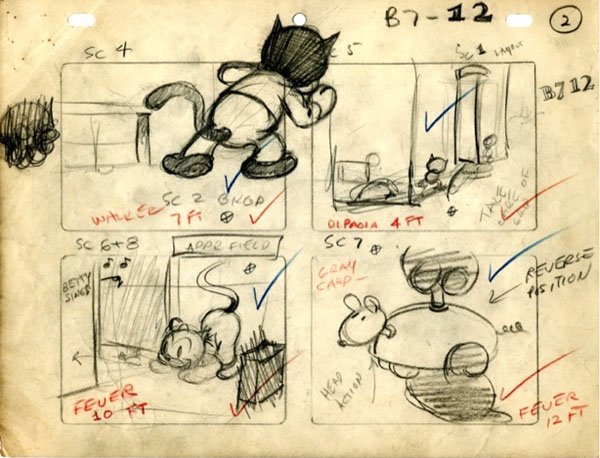

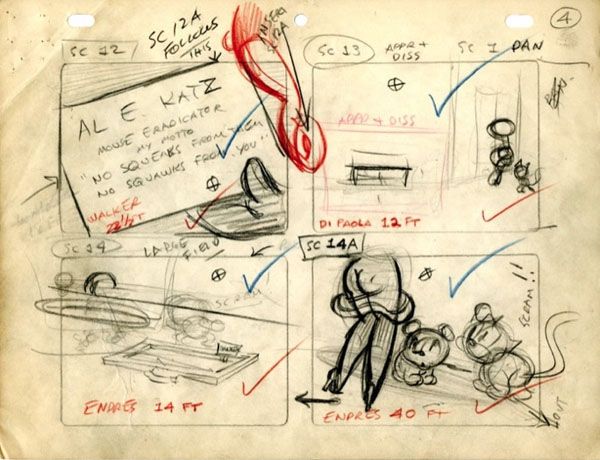
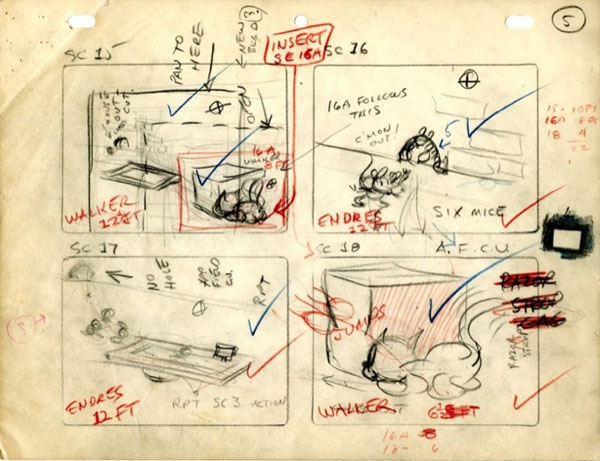
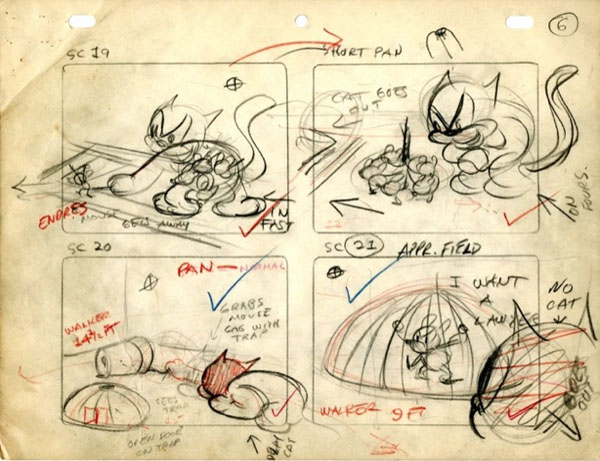
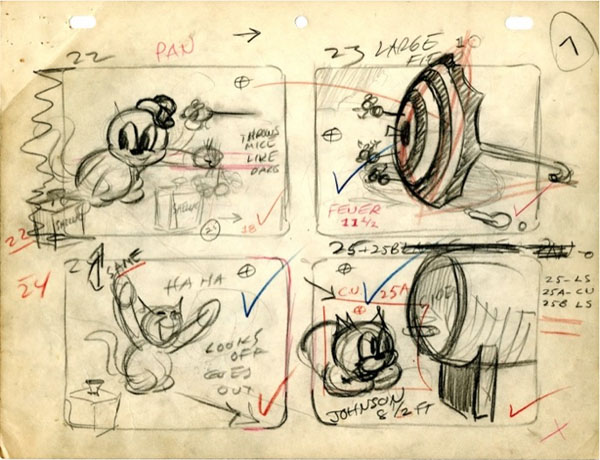
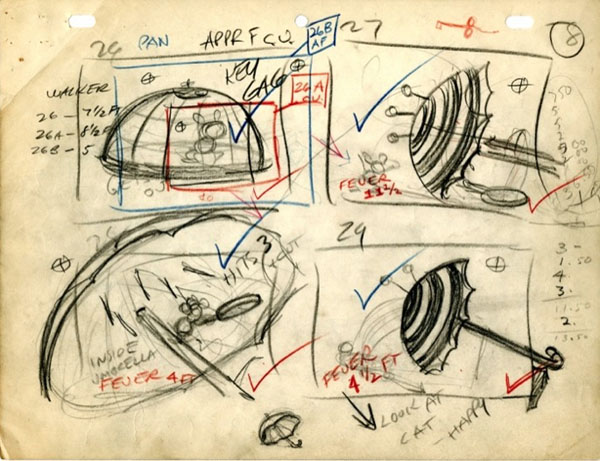
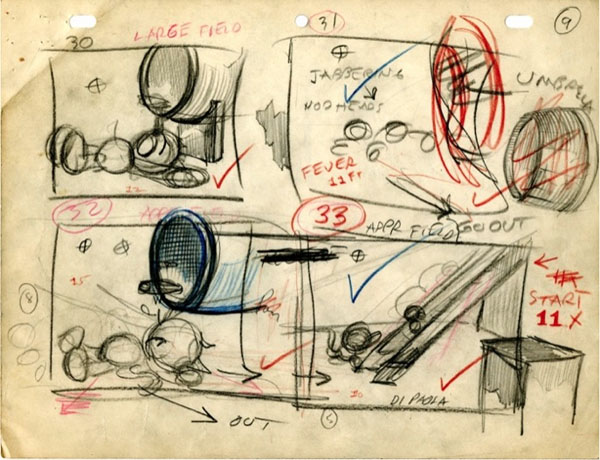

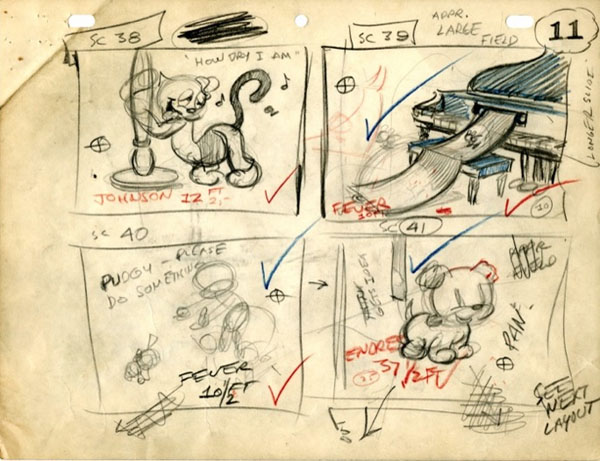
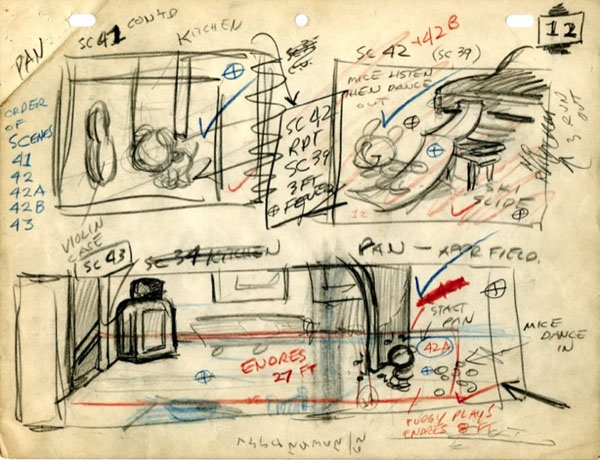

(Special thanks to Bob Jaques, Todd Levine, John Vincent and Jerry Beck)


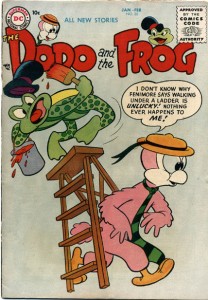

 DEVON BAXTER is a film restoration artist, video editor, and animation researcher/writer currently residing in Pennsylvania. He also hosts a
DEVON BAXTER is a film restoration artist, video editor, and animation researcher/writer currently residing in Pennsylvania. He also hosts a 





















































































Looking again at the scene of the cat winking. In my post I suggested it could have been done as part of the previous scene but simply fielded differently. Not sure why I said that. Actually, they look like distinctly separate scenes to me now. Who did the animation though I have no idea.
I believe you mean during the production code instead of ‘post-code’. Post-code would be after the production code ceased to exist in the late 60’s.
Storyboard drawings are suppose to be blueprints for the film – not works of art. This particular one doesn’t need any explanation – unlike modern boards that need description because they are shipped to other countries for layout and animation, everything was done within the studio. The board process was flexible, adding and deleting scenes as needed during production. The scene in question with Al E. Katt was most likely an afterthought, and is important character beat revealing him as a con man.
On a side note – the poster drawing of Betty looks like she’s been pumping iron.
Jerry-
I’ve the feelin’ that you got the idea to post “Baxter’s Breakdowns” from all the e-mail I sent you! If you did, thanks for listening. Devon is certainly the right fella to head this feature. Keep it up!
Devon, I think you did a great job!!! Of course I have to say it is sort of cool seeing part of my collection here!!!
Uggh……not this short. There are better ways to dispose the villain than having him getting drunk on the job!
Suprisingly, some of the animators worked on 1946 Noveltoon, “Old MacDonald Had A Farm”….no wonder that short has a cutesy Fleischer feeling mixed with Harveytoon-era designs!
This cartoon is interesting because even Pudgy himself is sidelined in the cartoon in favor of a different cartoon character (the sleazy cat mouser)
And frankly, any stand-in for Pudgy is an improvement.
Oh, and the transfer really is stunning.
And gotta love the that attention to detail on storyboard page #4….
I guess they realized the code couldn’t dictate the contents of their storyboards.
Does anyone know whether this “new transfer” was done with the original negative, or just an old TV print? I know that the Paramount logos were cut off the original negatives, but I thought that the Paramount copyright lines and the original transitions to the animator credits were still on them, since most of the Boops with the “proscenium” opening still have them. But if they were cut off the original negatives too, that means that many of the 1935 and later Boops (as well as Talkartoons and other B & W Fleischer cartoons) have lost their animator credits.
I believe that the new transfers (for the Olive releases) were done off the original negatives – however, recent research by Steve Stanchfield has shown the original credits may still exist on another element (a master positive).
The Tom Johnson-helmed Pudgy cartoons tend to go more for straight comedy, while the Myron Waldman Pudgy efforts are heavier on the cuteness. So it’s not a shock to see he focused on the cat here, as the more likely source of comedy (though when Waldman kept his cuteness preference in check and focused on the annoyances of dealing with the New York City subway, “Riding the Rails” was probably the best cartoon featuring Betty’s pet pooch).